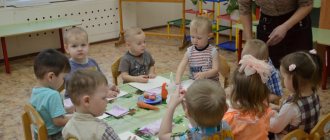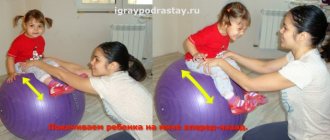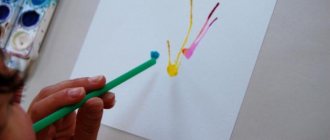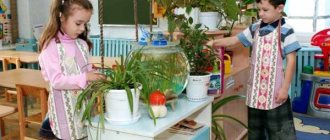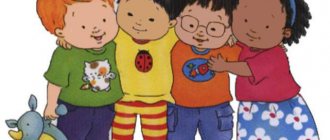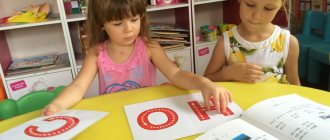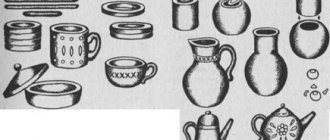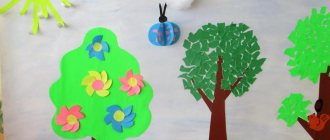Children grow so quickly that it seemed like not so long ago that the baby was just learning to walk and talk, and now he’s going to school. In Russia, 6–7 years of age is considered optimal for starting school life. But the modern curriculum is so difficult that it will be difficult for children without special training to keep up with it.
Many parents think that if the child went to kindergarten, then they will prepare him for school. In a sense, this is true, but parents can also conduct preparation for school and educational activities for children 6–7 years old. Children perceive something new better if their closest people help them in their studies.
This is important because only parents can know with confidence about the individual characteristics of their children. Even the best teachers will not be able to determine what a child will learn better and what worse, when he is capricious and when he really cannot understand. But you need to choose the right activities so that they bring maximum benefit. And today we will help with this.
Mission of development classes in the preparatory group
Before talking about the goals and objectives of developmental activities with children 6–7 years old, it is necessary to decide what an activity is. In the methodological literature, this term is understood as an element of the educational process organized by structure and time, designed to solve its specific goals and objectives. Classes are direct educational activities (DEA), which are characterized by three areas of goal formulation: teaching, educational and developmental. Thus, any activity is developmental.
Continuing the work strategy begun in the senior group, the goals of such lessons in the preparatory group are:
- consolidation of skills that characterize the norms of age-related development of children 6–7 years old (concentrate on completing a task, be able to anticipate the results of completing a task, etc.);
- bringing the conditions of interaction in the GCD process as close as possible to a lesson at school (strict adherence to the rules, for example, to answer or ask, you need to raise your hand, increasing the duration of the lesson to 30–35 minutes);
- nurturing the spirit of collectivism (in classes, preference is given to group forms of work).
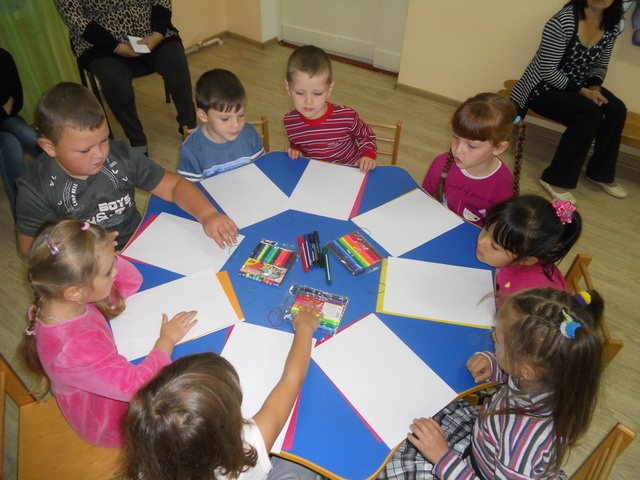
In developmental classes, children continue to learn to work together
Objectives of developmental classes in the preparatory group
The implementation of lesson goals is possible subject to the consistent solution of educational tasks, which are determined by the general level of development of preschool children 6–7 years old in the areas of intellectual, physical and mental development.
Table: objectives of developmental classes by educational area
| Region | Features of development | Objectives of developmental classes |
| Cognition |
|
|
| Social and communicative development |
|
|
| Physical development |
|
|
| Speech development |
|
|
| Artistic and creative development |
|
|
This is interesting. The teacher, building work with the parents of pupils, orients mothers and fathers to the designated development tasks, which makes it possible to implement the principle of continuity between the kindergarten and the family in the educational process.
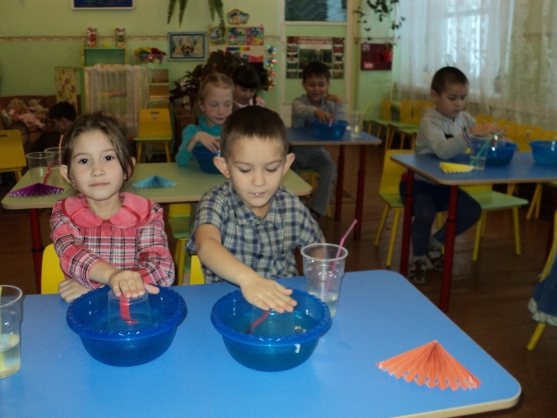
Practical development of life is an important task of developmental classes
Developmental tasks for children aged 6–7 years
In order for children to be fully prepared for school life, it is necessary to prepare the baby almost from birth, gradually making the tasks more difficult. And then by school age the child will feel confident at his desk. It is advisable to increase the load immediately before going to school.
Experts say that there are three factors in the readiness of children aged 6–7 years:
- Physiological. Simply put, this is the level of health. Will the child be able to physically withstand the stress that schooling entails? The doctor determines compliance with this indicator. Usually at this age, children are already quite ready to fully “gnaw on the granite of science.” If there are deviations in the health or development of the baby, most likely he will have to study in correctional classes. But parents should remember that frequent colds are not a reason for such grouping.
- Psychological aspect. This includes the development of the child’s thinking, memory and speech. The child must be able to communicate not only with peers, but also with adults, not throw tantrums due to comments, and be responsible enough to study, and not just attend classes.
- Cognitive aspect. Children aged 6–7 years should already have access to certain knowledge about the world around them. At a minimum, the child must understand basic concepts, be able to eat independently, know types of transport, etc.
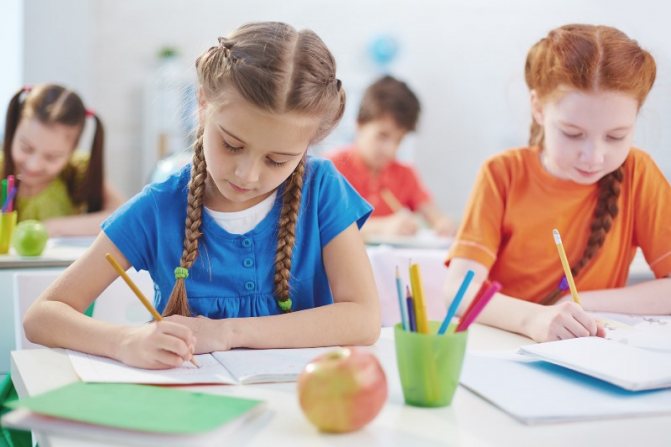
His parents can teach him all this. Below we have given several activities that will help your child quickly master all the skills that he will need in school life.
Attention
Children as young as seven need to be attentive enough to be able to hear and see the information being presented. At the time of entering school they should be able to:
- work according to the model;
- do tasks to find similarities and differences;
- focus on what needs to be done rather than what they want to do.
Simply put, at this age children should develop voluntary attention. Sometimes kids are “late” with this, and the task of parents is to form the ability of their child to voluntarily concentrate attention on things that may not arouse his interest. The easiest way to conduct such activities is in a playful way:
- "Body parts" . You need to seat your child opposite you. Then you raise your hand and say “hand”, raise your leg, saying “leg”, point to your ear, saying “ear”, etc. In this case, the child must repeat after you. The next stage is when you show your finger, but say, for example, “nose”. The kid must catch the trick and say it correctly. It is important to say incorrect names between correct ones so that the child remains focused.
- "Find differences" . Select any pictures with differences. For example, you can take the “Similarities and Differences” notebook. Before the game, be sure to discuss with your child how many differences there may be in the drawing, so that he does not rack his brains in vain. In order not to miscalculate, it is advisable to give the child a pencil with which he will trace the differences found.
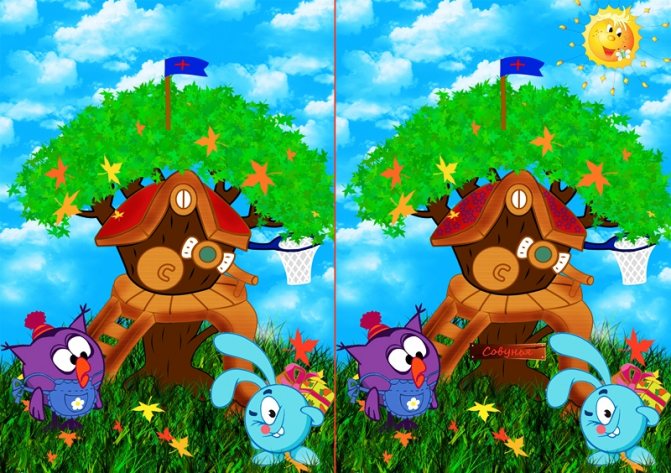
- "Find a way" . We take a picture from the notebook “Labyrinths. Around the world". The child needs to find the right path along which to go from point “A” to point “B”. You cannot cross the lines.
There are many other games that you can choose individually for your child, taking into account his interests.
Logics
Logical thinking at this age can already be at a fairly high level. The child must be able to:
- identify patterns in a number of subjects;
- highlight the unnecessary;
- classify according to characteristics, etc.
To strengthen these skills, you need to practice something like this:
- Find extra transport. To do this, you need to give the child a drawing, for example, on which a bus, a truck, a car, a scooter and a helicopter are drawn. Naturally, a helicopter would be superfluous, since it does not drive, but flies. But in order for a child to cope with this task, he must be familiar with the topic of transport.
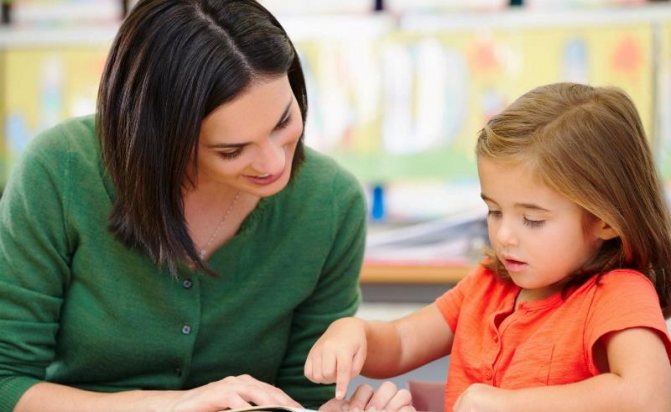
- “Whose shadow is here? ” In front of the baby is a picture in which there is only the outline of an object or animal. He must find out whose shadow it is.
- Continue the logical series. For example, in the drawing there is a circle, a square, a circle in succession, and the child needs to be told which figure will be next.
You can find even more interesting activities to develop thinking in the notebook “Logic. Level 2." It is important that the activity is interesting to the child, then he will quickly grasp what is required of him.
Memory
The memory of six-year-olds also has its own requirements. The child must:
- memorize short poems and recite them by heart;
- retell short texts;
- remember up to 10 images.
At this age, voluntary memory is formed. That is, the child can force himself to remember. At the same time, verbal-logical memory also develops, thanks to which the preschooler better remembers what he has managed to understand.
Tasks to improve a child’s memory:
- “Memorize and repeat.” You must say “tree” - the baby repeats it. Then say “tree and flower”, the child repeats again, and so gradually increase the verbal range until 8 words are accumulated.
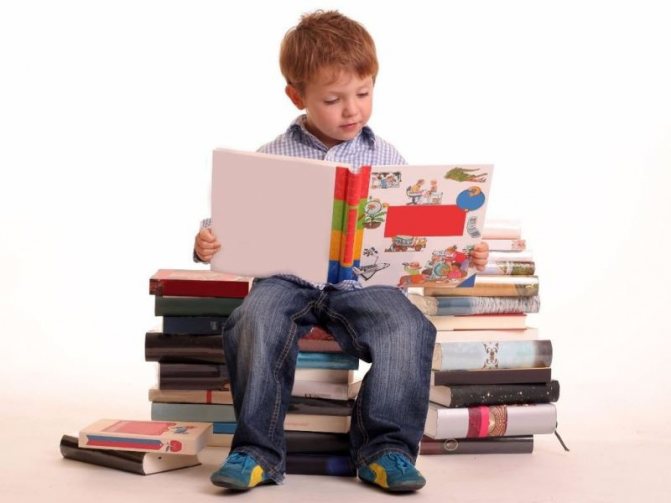
- “Remember the picture.” You need to put a picture in front of the baby and give him a few seconds so that he remembers what is drawn there. Next, turn the image over and start asking leading questions. For example, “What color is the boy’s T-shirt?”, “What do the kids play with?” etc.
- Games with objects. Take out several toys and place them in a certain order in front of your child. You can simply place it randomly around the room. The child must remember what is and where it is. Ask him to turn away or leave the room, and at this time rearrange the objects. Invite your child to turn around and name what has changed.
It is important not to overload your six-year-old. It is difficult for him to play monotonous games for a long time, and memory and attentiveness may deteriorate if he plays for a long time.
Horizon
Before going to first grade, your child definitely needs to talk more about the objects and phenomena that surround him. By this age he should already:
- know colors;
- animals and birds that live in his region;
- distinguish between seasons;
- know about professions, at least what his parents work;
- know transport, etc.
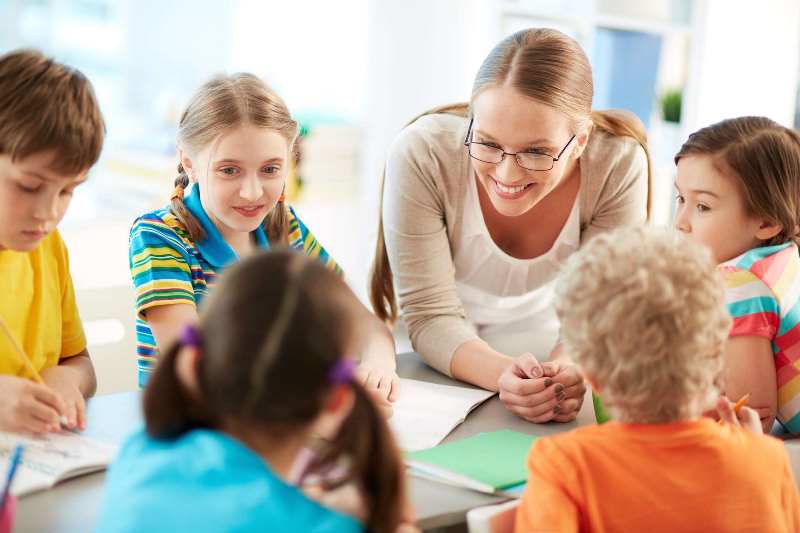
The broader the child’s horizons, the better for him. And you can develop it as follows:
- Use cards from the “The World in the Palm of Your Hand” series with different objects. For example, plants, animals, furniture. As well as cards with representatives of different professions. For example, a driver drives a car, a doctor listens to a patient, etc.
- Game "Dishes and cutlery". Describe some cutlery. For example, a fork. Say that it is a metal object with sharp teeth. The six-year-old must guess what it is. By analogy, describe a kettle, frying pan, etc.
- Quests "Seasons". Name the season, and the child must name its signs. These could be statements about the weather or what the child is doing at that time. For example, in winter you can go sledding. You ask why he can do this. A six-year-old, for example, must answer that this is possibly due to the cold weather and the snow that has fallen.
Walk with your child often and tell him everything you see.
Time and space
Preparing a child for school should include increasing his knowledge of time and space. Guys should not confuse concepts such as:
- morning, evening, day and night;
- yesterday and today;
- Seasons.
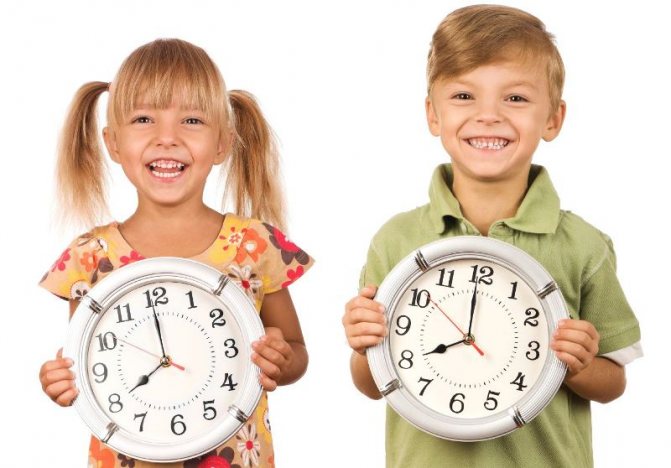
At the age of six, children can and should be introduced to the calendar, in particular, the months and days of the week.
- Getting to know the time of day. Take pictures that show scenes from your life that you are doing at a certain time. For example, they get ready for school in the morning, walk outside during the day, watch movies in the evening, and sleep at night. Ask your child to arrange the cards from morning to night.
- Finish the sentence. The game is for the child to complete a logical sequence. For example, “we ski in winter and swim... (in summer).”
- Days of the week. Good to play if there are several children. You need to stand in a circle and, having named the day of the week, throw the ball to another child, who must name the next one. For example, saying “Monday”, throw the ball to a neighbor who says “Tuesday” and throws it to the one who says “Wednesday”. The sequence can be changed later.
As for spatial skills, the child must know where right, left, up, down, forward, backward and others are. You can strengthen these skills with games. For example, ask your child to bring something, saying “to the right of the table”, “on the top shelf”, “below”, etc. In practice, such skills are learned best.
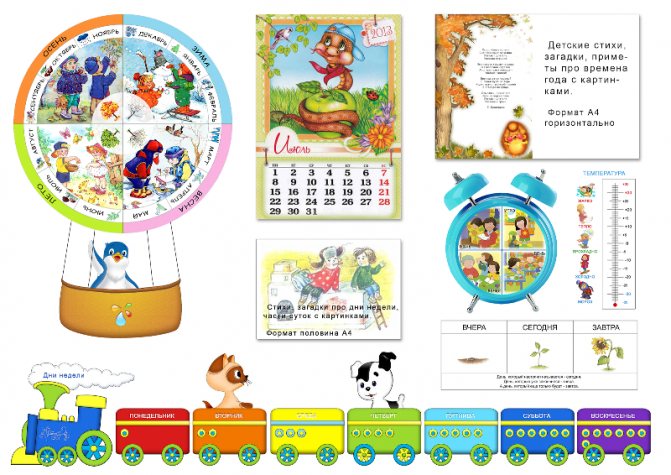
Colors
When we prepare a child for school, we need to make sure that he distinguishes colors and knows their names. To help him master this, we offer several interesting activities.
"Colored" steps. This game will consolidate knowledge about primary colors and help the child distinguish between their shades. In addition, you can move here, which develops reaction speed. But it is better to play in a group of 8-10 children. To prevent your child from getting bored, you can invite his friends.
Progress of the game:
- the children need to stand in a row, and the leader turns his back to them;
- the presenter says “those who have green in their clothes - come forward”;
- the presenter turns around, and those who came out must show the designated color;
- then the leader turns again and, calling a different color, says that those who have it take two steps back and so on.
The peculiarity of this game is that children wear multi-colored clothes, therefore, even if someone has already walked, they can do it many times if they name the color that they have in their outfit. The child who approaches the leader first takes his place.

Another interesting game is called “Collecting treats.” For it you need to pick up several multi-colored napkins to match the color of the spoon, fork, cup and bowl. You can take plastic ones, especially since multi-colored plastic dishes can be bought everywhere, and they are inexpensive.
Further actions are as follows. Mix all the items together and give the child the task of assembling a set of each color and correctly naming the color. Moreover, it is important that the dishes are collected carefully, because you need to eat from them.
The game can be complicated if you buy candies of the same colors as the dishes, mixing them with those that do not match the color of the dishes. The child sorts the matching candies into plates. This will definitely add excitement to the young students.
Types of developmental activities in the preparatory group
The implementation of development tasks according to the guidelines of the Federal State Educational Standard (FSES) accompanies the entire educational process in kindergarten, but is most pronounced when organizing educational activities. The list of disciplines is expanding in comparison with the senior group:
- mathematics (2 times a week);
- speech development (once a week);
- literacy training (once a week);
- physical education (3 times a week, in some kindergartens one of the three classes is allocated for sports games, and separately for boys and girls, for example, pioneer ball and aerobics, respectively);
- familiarization with the outside world (once a week);
- ecology and basic life safety (once a week);
- artistic creativity (drawing 2 times a week, sculpting and appliqué 1 time);
- design (once a week);
- music (2 times a week).
If the kindergarten work program provides for it, then 1–2 hours a week in the work schedule are allocated for choreography (or logorhythmics, rhythmoplasty) and a foreign language (English).
The tasks of the comprehensive development of preschoolers are also included in routine moments, as well as in preparing entertainment and organizing outings, suggesting:
- developing a culture of hygiene skills in the aspect of self-care, following the rules of a healthy lifestyle;
- accumulation of experience in the emotional-volitional sphere;
- development of intelligence, independence;
- continuation of work on the formation of moral qualities of the individual and a sense of patriotism.
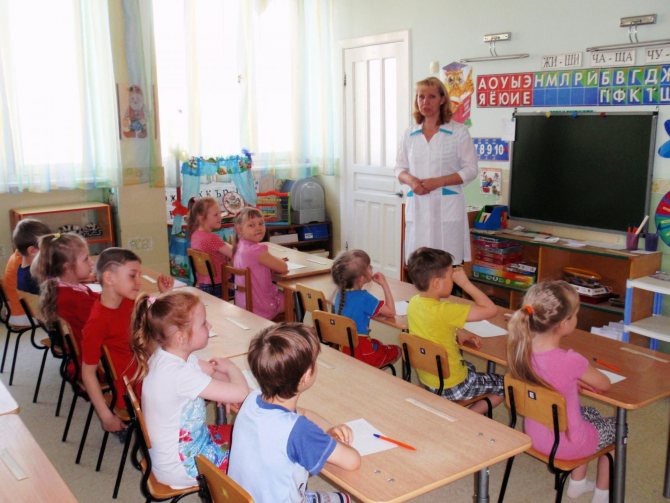
There is a developmental component in every element of educational activity in a preschool educational institution.
Methods and means of preparing developmental classes
Developmental classes require a careful selection of a combination of methods, that is, a set of ways to implement educational tasks. In this case, the unit of implementation of the method will be a technique - a practical element of work, which, in turn, requires the rational use of means - a set of objects of the subject-development environment and tasks, that is, exercises.
Below is a table where all these concepts are combined into a single system aimed at achieving the objectives of developmental classes.
Table: methods, techniques and exercises for development classes in the preparatory group
| Method | Reception | The essence | Exercises |
| Speech | Questions | In the preparatory group, this technique helps to implement a heuristic approach to acquiring new knowledge: children themselves reach new knowledge. | “Create your own version of a fairy tale” (to develop imagination). The teacher invites the children, based on the answers to the questions, to create their own version of the development of the plot in the fairy tale. Questions for the fairy tale “Turnip”:
|
| Instructions | It is used in developmental classes in physical education, artistic creativity, speech development, physical exercises to guide the progress of children’s work. | At a speech development lesson on the topic “Here the kittens are acrobats,” the teacher invites children to make up sentences with the words: circus, cinema, park: “Look at the cards on the board. Read the words and make up sentences with them.” | |
| Explanation | In parallel with explaining the material through explanation, the teacher develops in children a sense of language and the ability to logically structure monologue and dialogic speech. | At a lesson on speech development on the topic “Polite Words,” the teacher explains to the children the origin of the word “Thank you”: “In ancient times, the word thank you was pronounced as “God bless”: this is how people thanked higher powers for their kind attitude towards them. Over time, the word turned into our usual “thank you,” and the meaning became more material - people express gratitude to each other for various kinds of favors.” | |
| Conversation | The dialogue form of working with children is the most productive, as it gives the children the opportunity to feel like adults, significant, and also, like explanations, helps them learn the rules for constructing logical statements. | In the preparatory group, conversations are conducted of two types: cognitive and ethical. You can see examples of both in the file of conversations for the preparatory group. | |
| Proverbs, sayings, riddles, poems | These techniques are commonly used to motivate children. Rhymes not only attract children's attention, focus them on joint activities, but also develop memory and vocabulary. | To begin considering the topic of music “Motley Pages” related to the study of the seasons, you can begin with a discussion of sayings and proverbs:
The topic of getting to know the outside world “Space” can begin with solving riddles:
Poems can be used not only at the beginning of a lesson, but also at the end, to summarize the study of the material. For example, a FEMP lesson on the topic “Geometric shapes” can be summarized with a rhyme, after listening to which, children name all the mentioned geometric bodies:
| |
| Tongue Twisters | Help kids practice diction. |
| |
| Visual | Images | The visual-figurative type of thinking of children requires rich illustrative material for each topic, which helps to move more easily and quickly to the next stage of perception development - abstract-logical. | |
| Demonstration | The teacher personally shows the entire procedure for performing the exercise. | In classes on the basics of literacy, the teacher shows the elements of writing letters, and on the applique - the order of applying image elements to the substrate. | |
| Show | Presentation of material in the form of videos. Typically used as a basis for conversation. For example, topics for developing ideas about safety in everyday life can be illustrated with a series of cartoons about Arkady Parovozov. Children watch the episode, and then discuss its content and, together with the teacher, formulate rules for safe behavior. | ||
| Observations | A technique that allows you to systematize knowledge about the world around you. | Examples of tasks within the framework of implementing various developmental tasks can be found in the observation file for the preparatory group. | |
| Game | Didactic | Used to familiarize, systematize, and generalize the material. | By clicking on the link, you can familiarize yourself with a card index of didactic games on various topics for children 6–7 years old. |
| Movable | Designed to help children practice basic movements, as well as satisfy the need for physical activity. | The card file of outdoor games in the preparatory group is presented here. | |
| Theatrical | Develops children's creative abilities and reveals their creative potential. | You can see examples of theatrical games here. | |
| Role-playing | They form ideas about patterns of interaction between people in different circumstances (in the hospital, at work, at home). | Examples of tasks can be found in the file of role-playing games for the preparatory group. | |
| Finger | They train fine motor skills, which helps prepare the hand for writing, and this is an important indicator of a child’s readiness for school. | "Cockroaches"
| |
| Practical | Experiments | Children learn to draw conclusions about the phenomena of the surrounding reality through practical interaction with it. | You can view the card index of tasks and the progress of experiments in the preparatory group here. |
| Modeling | Creation of models illustrating connections between elements and properties hidden from direct view. Modeling can be a method of implementing the task of involving parents in educational activities, when children together with adults create models. | Modeling can be made from building material (constructor parts, mosaics), or it can be made from paper. For example, when studying the topic “Modes of Transport,” children make a ship from Lego parts using a design diagram. A version of the project with parents is the “Roadway” layout, with the help of which children can practice traffic rules. | |
| Drawings | A technique that is used not only in classes on artistic and creative development of the corresponding profile, but also as an element of consolidating material in classes in various educational areas. In the preparatory group, children practice previously learned non-traditional drawing techniques (monotype - mirroring traces of paint by applying patterns on one side of a sheet of paper folded in half, drawing with soap bubbles, stamps, etc.). Examples of a card index of drawing themes in non-traditional techniques can be seen in the publication of teacher Pylnova D.K. | ||
| Applications | Like drawings, applications are used in lessons in various areas. For example, to get acquainted with the outside world and consider the signs of different seasons, the applique can be made from pieces of colored paper. | ||
Video: presentation reception - a large collection of tips from Arkady Parovozov
Video: experimenting “Molecules and Bubbles” at a developmental lesson on familiarization with the environment in the preparatory group
Photo gallery: practical techniques in developmental classes
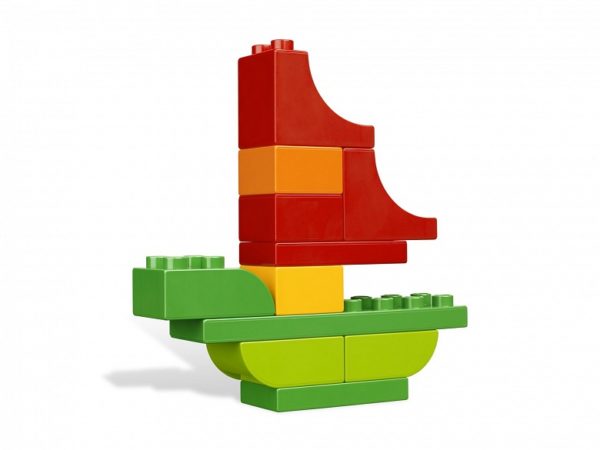
In the process of modeling from building materials, children learn to disassemble assembly diagrams
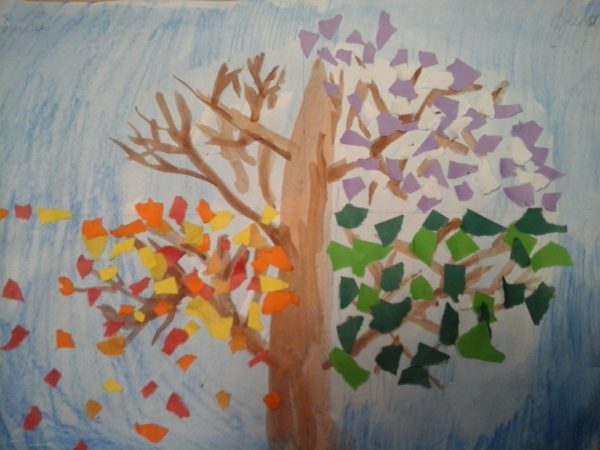
Imaginative representation of different seasons develops creativity in children
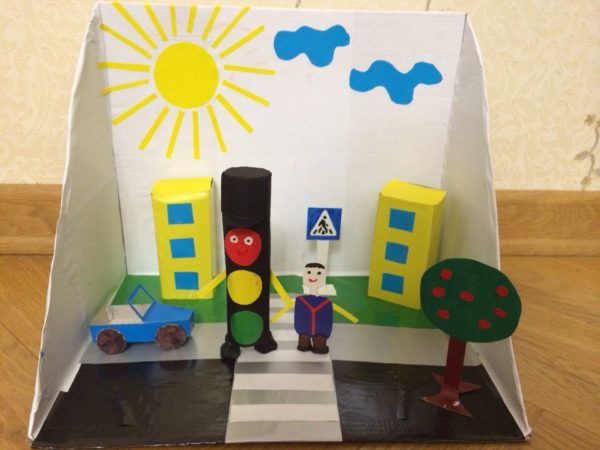
Completing challenging crafts can be a group activity or a project for children and parents
Mathematics
Children of senior preschool age should already be able to do a lot by the age of seven. Their list of knowledge includes:
- ability to solve simple problems and puzzles;
- know what it means to add or subtract, and distinguish between the signs “+”, “–”, “=”, “<” and “>”;
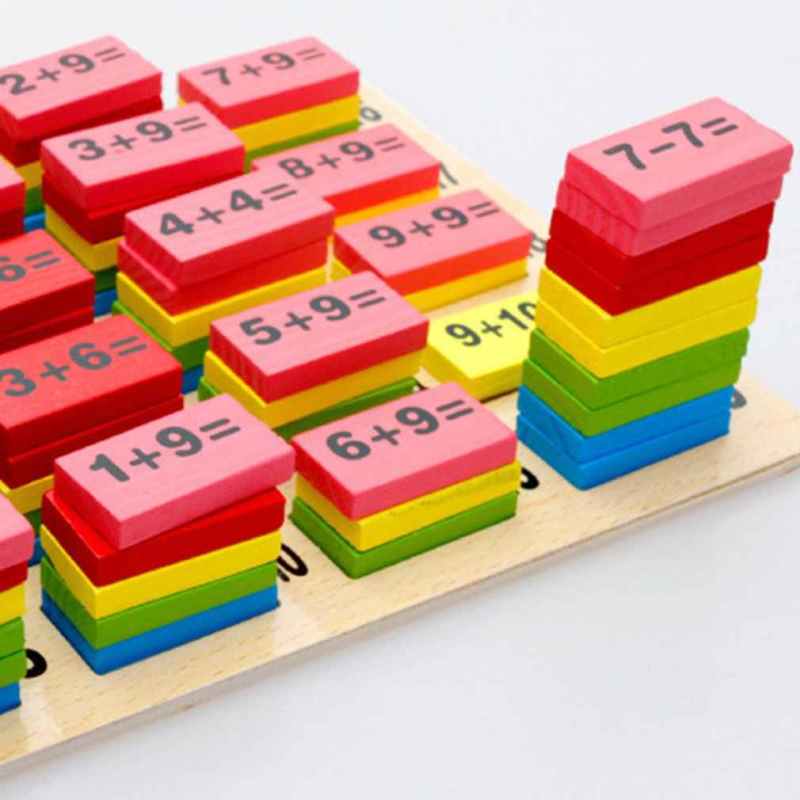
- be able to count to 10, performing operations with sets, count both forward and backward;
- make comparisons in terms of “less”, “more”, equal or unequal;
- understand how to answer correctly when the question begins with the words “how much, which, which number”;
- distinguish shapes - round, square, triangular and rectangular, and divide them into parts (semicircle, etc.).
If your baby doesn’t yet know how to do any of the above, that’s okay. This can be corrected with special training. The main thing is to do them regularly, and the child will quickly master what he did not have time to learn before.
Parts of the whole
The child must understand that something whole can consist of several parts. This is best explained using geometric figures. That is why we chose the following tasks:
- Print out cards with several geometric shapes of different shapes. Then the child must watch carefully. For example, two triangles can be used to form a square or rectangle, semicircles form a circle, etc.
- Math puzzles. With their help, the child will not only learn to select the necessary parts, but also understand their spatial position. For example, if a piece of a puzzle is turned the other way, even if it is correct, the piece will not be suitable for forming the whole.
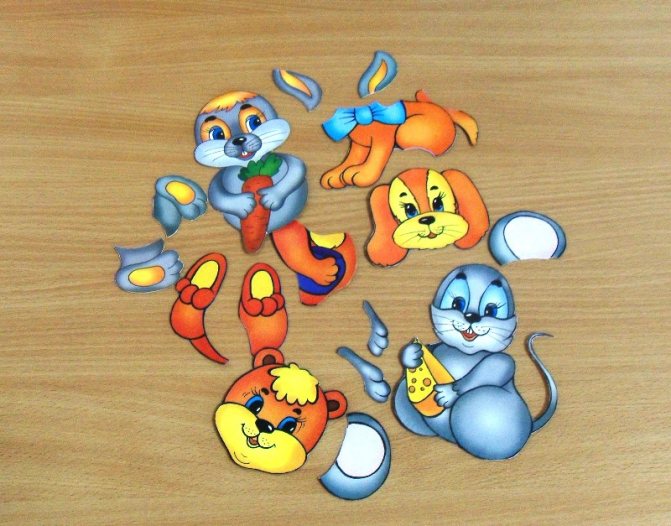
- Figures of different shapes. This is a three-dimensional example of how to put parts together into a whole.
The beauty of these activities is that you don't have to buy anything separately. To practice with pictures, you can simply print and cut them out. Puzzles can also be printed, but on thicker paper.
Counting to 10
Seven-year-olds should already be able to count to ten and try to perform simple mathematical operations with numbers. If the child is still lost, special tasks will help him better understand the material:
- Math puzzles. The essence of the game is that to get the correct picture you need to assemble the puzzle pieces in order. That is, from 1 to 10. You cannot rearrange the numbers, but you can start counting not from one, but from 10. This will help the child learn to count both in the correct order and vice versa.
- Counting books with coloring pictures. The game format of counting allows it to be learned even by children who are not particularly inclined towards exact sciences and studies in general. Under each number there is a color, but to recognize it, you need to be able to count and perform simple mathematical operations.
- Copy-numbers. Children will learn to not only count correctly, but also write each number. To do this, it is best to use the saying “Learning and growing. Numbers from 1 to 30”, where the child will be able to print the necessary symbols by following the dotted line.

Today there are many other interesting tasks, so don’t stop at the ones listed. And don’t forget to gradually complicate the tasks for your child.
Count to 20
The next step in teaching a young mathematician is to teach him to count to 20. The transition to tens sometimes becomes real stress for a child, but if everything is organized correctly, you can quickly master counting, at least to 20. The following problems will help with this:
- Connecting even and odd numbers from 1 to 20. Here children learn by connecting even (2,4,6,8, etc.) numbers with each other, and by the same analogy, odd (1,3,5, etc. .). This way, the kids will learn not only to count, but also to do it at random. And naturally, they will understand which numbers are even and which are not. All tasks make sense, because by connecting certain numbers we build a path along which the cartoon character seems to have to go. The child finds this interesting.
- Table with numbers, some missing. The task contains several sheets that are intended for children with different levels of knowledge. For example, on the first sheet you can make a table counting up to 10, on the second - up to 20, on the next - up to 50 and up to 100. And so with one tool you can learn the first hundred. In addition, the child will be able to better remember how these numbers are written, because he must enter them.
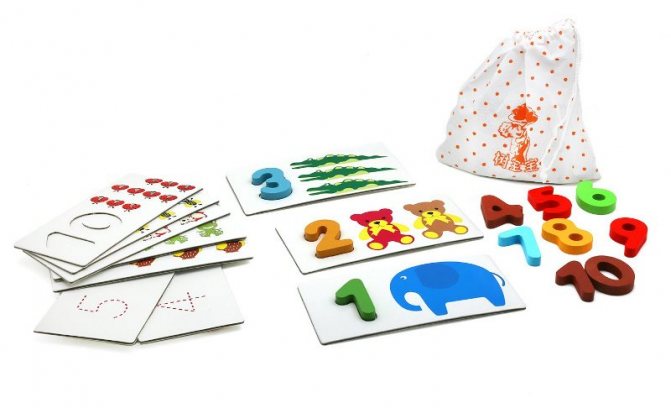
- Cards with numbers. Each number should be on a separate card, and it is desirable that there is something else on the picture. For example, if the number 19 is drawn, the picture may show a hen with 18 chicks. That is, the number of items should be exactly as much as the indicated number indicates. This way the baby will master not only numbers, but also the concept of quantity.
You should not leave your child alone with these tasks - help him.
Counting to 100
Today we’ll look at one, but universal, way to teach a child to count within a hundred. Moreover, it is much more effective than various coloring books or copybooks, and all you need for this is 10 boxes of matches. But it is advisable to cover them with multi-colored paper. You will also need paper squares with numbers from 1 to 100 written on them.
Show your child what is required of him. Take one match and find a square that says “One” on one side and “1” on the other. The baby must repeat your action up to 10.
Having collected 10 matches, you need to take a box and put the selected matches there. The child needs to be explained that the number of matches collected in the box is ten. One box – 1 ten, two boxes – 2 tens, etc. since every new 10 matches must be hidden in a new box.
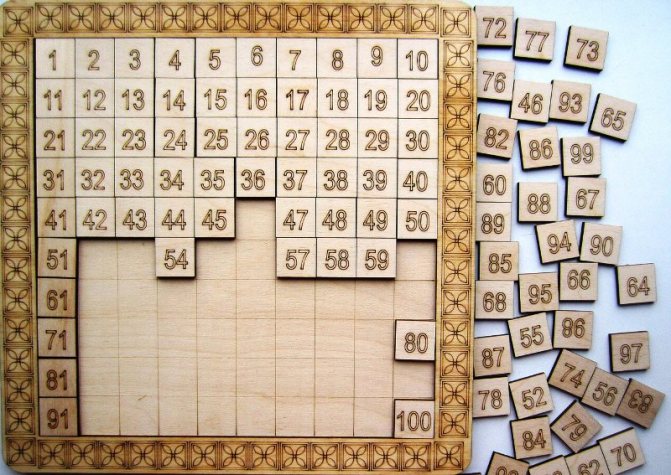
Next, explain to your child that tens are called “Twenty.” That's what they were called in ancient times. You can even write this on the box.
Take one match and place it on the box. It turns out to be “one in twenty”, but is pronounced as “eleven”. For clarity, you need to put a card with this number next to it. Further by analogy - “twenty-twenty”, “three-twenty” and so on until 19.
When 10 new matches are collected, they again need to be hidden in a new box. That is, another “twenty”. We get two boxes, that is, “twenty.”
Place one match next to the two “twenty” boxes. We will get two “twenty” and one match, that is, “twenty-one.” On the card next to it show how it is written. And so continue until 40.
Now is the crucial moment, since the word “forty” has nothing to do with the number “four”. A small brain accustomed to the simple analogy shown above may become confused because the number is supposed to sound like “four.” It is not interesting for a child to delve into the linguistic jungle, but listening to a fairy tale is the opposite. For example:
Once upon a time there lived three faithful friends - Twenty, Thirty and Fourty. Twenty was soft and fluffy, Thirty resembled a gray pebble, and Four sparkled like glass in the sun. When the guys wanted to take a walk, a magpie saw them. Since these birds are very fond of everything shiny, the magpie grabbed Fourty and dragged her to her nest. Since then, his friends have been saying everywhere that their companion now lives with the forty. And they do this so often that everyone around them began to call Fourty “Forty.”
If everything then goes like clockwork, then when you reach the number 90, a problem similar to the number 40 arises again. Ninety can be called that because nine tens so want to become a hundred that they even call themselves “nine-hundred.” If you add another ten to 90, it becomes a hundred.
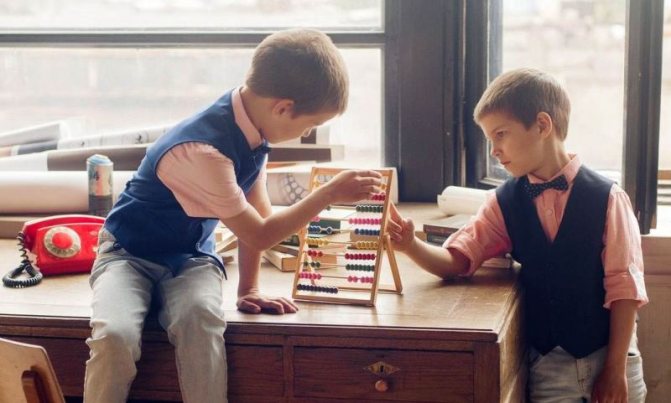
Learning shapes
Playing with geometric shapes develops the baby. To study them, you can use the educational set “Form. Color. Size". Cards with pictures of geometric shapes of different colors are also used:
- The child receives cards that show from one to five figures. He must arrange them in ascending order.
- Find the same shapes on the cards, name them and what color they are.
- Lay out the cards and let the child list all the figures that are drawn there. Moreover, say what kind of figure is the first, second, third, etc.
- You can complicate the task if you ask the child to name the figure, for example, between a red square and a green triangle.
You can use other equipment. Even household items. For example, the closet is rectangular, the ball is round, mother’s perfume is triangular in shape, etc.
Comparison
At the age of six, a child must understand what more or less is, that is, compare mathematical concepts. A child learns best through visual examples.
That is why you can take cookies or candies and put them in two piles, making one a little larger in advance. The child must count the number of items in one and the other pile and say which one is larger. Ideally, it would be nice if he said how much bigger it is.
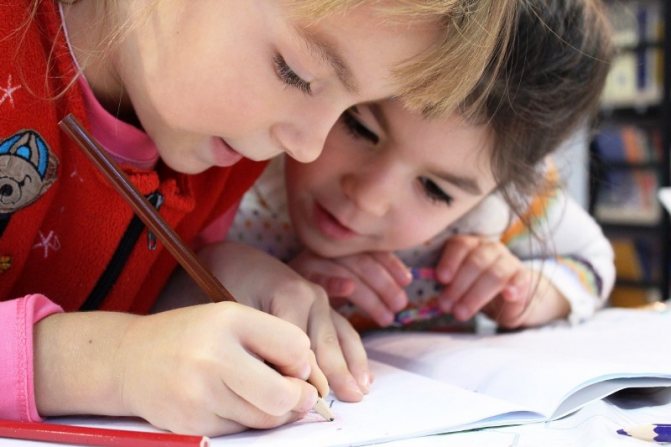
Card files of exercises for the preparatory group
As already noted, the main goal of working with children 6–7 years old is to prepare for school. In this context, it is important for the teacher to methodically correctly select exercises for the development of key skills (reading, writing, counting, etc.). You can see an example of a card index of development exercises here.
Exercises of a narrow specialization, namely for the development of graphic skills, can be viewed here.
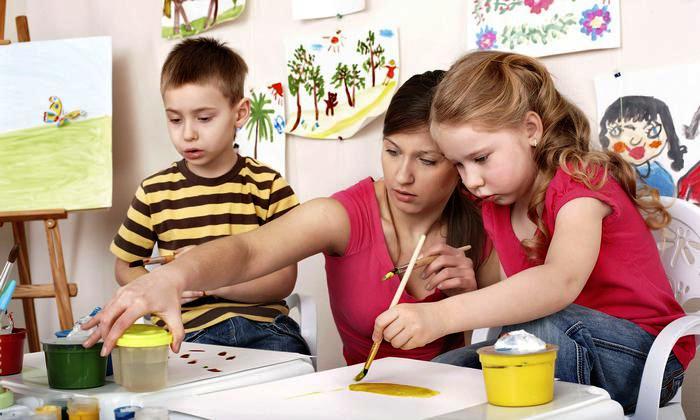
The teacher must select tasks so that children can develop all the skills and abilities necessary for the next stage of education.
Why prepare for school
With the arrival of a child in an educational institution, his leading activity changes: there was play, now there is study. And in order to cross this line with the least stress and “losses,” teachers strongly recommend starting preparation for training at least six months before September 1.
Not only the educational moment is important here, but also the psychological one. And if in the usual offline mode, attending preparatory courses, it is easier for a child to understand what awaits him (the mode, appropriate reactions to the actions and words of the teacher, speed, etc.), today this task falls on the shoulders of the parents. Explain, tell and show how it will be.
As for the educational aspect, the resources we offer below will help.
How to set up a development center in a preparatory group
The subject development zone is the location of visual aids used in the classroom to implement development tasks. This corner of the subject environment is distinguished by a wide variety of materials, which can be grouped into several blocks of factory-made or home-made materials.
Table: distribution of materials in the development center
| Purpose of the center | Materials |
| Sports zone |
|
| Creativity zone |
|
| Game (materials for dramatizations, role-playing games can form a separate zone - a theatrical corner) |
|
| Musical |
|
| Speech development |
|
| Reading zone (often combined with the speech development zone) |
|
| Math zone |
|
| Experimentation zone |
|
| Construction area |
|
| Wildlife Zone |
|
| The labor part of the subject-development environment |
|
Video: game “Teremki” using V. Voskobovich’s cubes
Photo gallery: an example of organizing a subject-development environment in a preparatory group
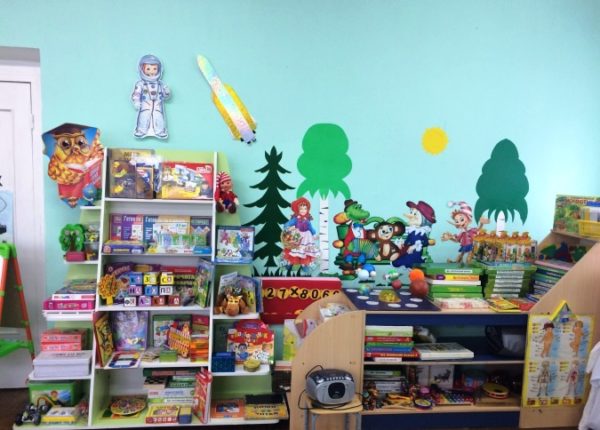
It is very important to maintain order in the areas of the subject-development environment
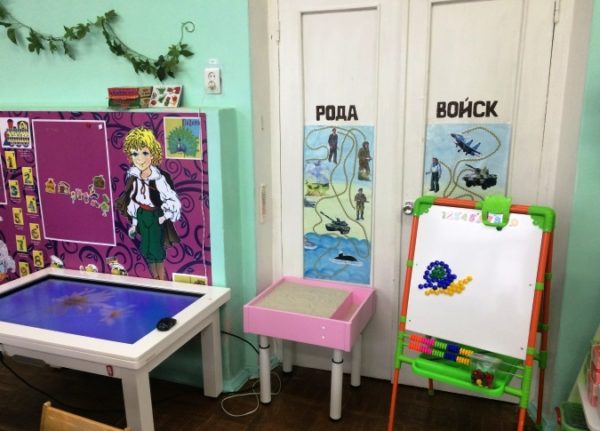
Technical teaching aids occupy an important place in the design of the subject-developmental environment of a modern kindergarten group
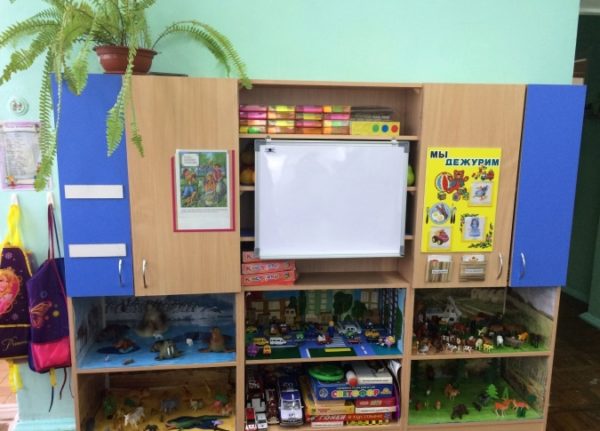
For separate zones of the subject environment, you can allocate a shelf, for example, for materials for didactic and outdoor games
Temporary plan for developmental classes in the preparatory group
A lesson with children 6–7 years old lasts 30 minutes and, as in other age groups, consists of four stages:
- organizational, designed to motivate guys to work (up to 3 minutes);
- the main one, which develops the topic using different methods and techniques, and also includes a physical education pause (up to 12 minutes);
- stages of consolidating the material, that is, practicing new material in tasks of a practical nature (up to 10 minutes);
- the final stage, at which the teacher and children evaluate their activities (up to 5 minutes).
This is interesting. The consolidation stage may not be allocated separately, but fits into the topic development stage.
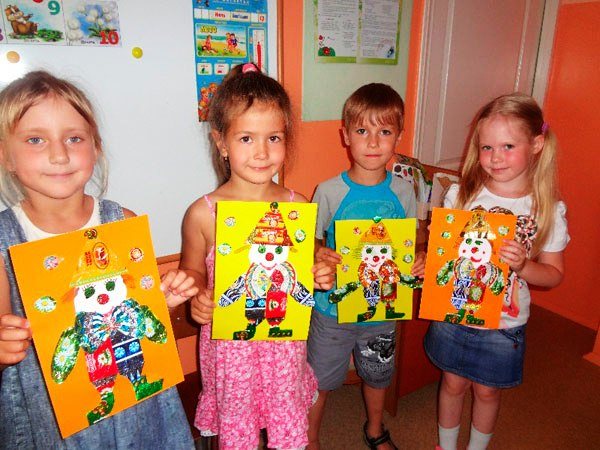
All stages of topic development must fit into the timing of the lesson in the preparatory group, that is, 30 minutes
Required Skills
Very often I hear from adults regrets that they were not taught important and necessary things at school. For example, how to handle money, how to properly organize your time, how to speak confidently and convincingly.
Modern parents have an invaluable opportunity to fill the missing gaps in school education and teach their children the necessary skills. And the following courses will help them with this.
Financial literacy for children 6–13 years old – Umnasia
The online course on financial literacy is designed for children aged 6 years and older. It will help the child form an idea of what money is, where it comes from, and how the Russian and world economy works. Training takes place in a fun and playful way. I liked that the course is divided into 5 steps. You can start with any one depending on the student’s level.
In a programme:
- developing healthy financial habits;
- formation of ideas about the real value of money;
- training in managing personal and family budgets;
- familiarity with common banking products (loan, deposit, etc.);
- introduction to the market economy and familiarity with the principles of company operation.
The course contains gamified tasks and interactive examples. It definitely won't be boring.
The cost of passing any one level is 1,990 rubles. All 5 steps can be completed for RUB 3,790. Upon completion, a certificate is issued.
Young speaker – Nadezhda Trofimova
Young Speaker is a special course for children 7–12 years old, in which they will learn to speak beautifully and confidently in any situation: when communicating with peers, while answering at the blackboard, or speaking in public. The course consists of 15 lessons of approximately 25 minutes each.
In a programme:
- practicing self-presentation skills;
- drawing up a plan and outline of a speech;
- ways to gain confidence before performing;
- expressiveness of speech and gestures;
- practicing various types of speeches: congratulations, announcements, excursions, reciting poetry and prose.
After completing this course, the child will forget what fear of public is, learn to speak beautifully, succinctly and emotionally, get rid of filler words, improve his voice and articulation. There is a lot of practice in the course. Homework is checked by a supervisor.
The cost of training is 3,800 rubles. Access to materials is available for six months.
Time management for schoolchildren – Veronica Lashuk
In the Time Management course for schoolchildren, your child will learn how to effectively manage their time. This invaluable skill will help him seriously simplify and optimize his entire subsequent life.
The course is quite comprehensive. It consists of 36 academic hours. This time is enough for students to learn and apply the necessary tools for planning, goal setting and work organization.
In a programme:
- how to manage everything and not get tired;
- why do you need to save time?
- the ideal daily routine of a schoolchild;
- SCRUM tools for time management.
After completing the training, a state certificate is issued.
Computer Literacy - Foxford
The Computer Literacy course will teach your child to confidently use a computer. It consists of 16 lessons, each of which has theory and practical tasks. The course is taught by programming teacher Roman Nikitin.
In a programme:
- computer device;
- training in computer graphics and animation;
- getting to know the Internet;
- Internet safety techniques;
- creating presentations;
- basics of web design.
Tuition fee – 1,990 rubles. One lesson can be taken for free.
Also take a look at our selection of computer courses for children.
Your creativity at the tip of your pen – Children's Art School
Your creativity at the tip of your pen - a free course on developing beautiful handwriting. Of course, this is not the most necessary skill in life, but it is an additional advantage to all the others.
The course is designed for children aged 9–13 years. It is taught by graphic design teacher Svetlana Rodina. In a programme:
- posture setting;
- history of writing, fonts, letters;
- learning to write in different fonts.
The course consists of 8 lessons of 30 minutes each. During the course, students complete tasks and post them on their social network page. The curator checks the assignments. To take the course, you must register.
Safety Lessons - Foxford
Safety Lessons is a course that will teach a child 4–12 years old the rules of safe existence in the modern world. It contains 10 video lessons of 10 minutes each. The animated characters Masha and the Bear from everyone's favorite cartoon will help you master the rules.
The following situations are considered:
- the child is teased at school;
- a stranger on the street offers a treat;
- an iron or other electrical appliance caught fire at home;
- a child gets lost in the city or in the forest;
- someone on the Internet asks for a home address and others.
The child will receive clear instructions on how to act in all these cases. Homework will help him consolidate and master the material. In addition, the course includes a test on knowledge of safety rules and a checklist for parents with a list of situations in which behavior must be discussed with the child.
Tuition fee: RUB 3,490. The first lesson is free.
Algorithm for compiling lesson notes
The lesson notes are the “skeleton”, the basis of interaction with children. Its compilation must be approached with special care, and this concerns not only the content, that is, methods and techniques in work, but also the form - the sequence of stages and the formulation of goals and objectives.
Table: structure of a summary of a developmental lesson in the preparatory group
| Composition element | Sample |
| Lesson topic, educational course, educational area. | “Journey to the Islands of Knowledge”, FEMP, “Cognition”. |
| Place of the lesson in the lesson system | Final lesson |
| Name of the group and age of the children Full name of the teacher indicating position and regalia | |
| Target Component | Identification of knowledge, abilities, skills of pupils of the preparatory group for school over the past period of the school year. |
| List of tasks | Training tasks:
|
Developmental tasks:
| |
Educational tasks:
| |
| Lesson content | A statement of the order and content of each stage of the lesson. |
Table: Shirshikova I.V. summary of a lesson on speech development on the topic “Retelling the fairy tale “The Fox and the Goat” in the preparatory group (fragments)
| Stage | Content |
| Organizational | The teacher asks a riddle: “The tail is fluffy, the fur is golden - who is the riddle about?” (About the fox.) |
| Shows the children several pictures of a fox: “When you were in the older group, you and I looked at different pictures. Now you can take any picture and say what kind of fox you have. If one has a red fox, then another has another... someone has a beautiful fox, and someone else..." | |
| Basic | The teacher expressively tells the fairy tale “The Fox and the Goat.” Asks questions: “What is this fairy tale about?”; “How does it start? Is it ending?"; “How is the Fox shown in the fairy tale? Why do you think she's cunning? How else is the Fox depicted?”; “What is the Goat in the fairy tale? Why do you think he is like that?"; “Which words and expressions did you like best?” |
| “Listen to the story again,” the teacher suggests, “then you will tell it.” Listen carefully and remember. 3-4 retellings are heard. You can invite the children to retell the fairy tale in roles (or as a group - “team”). Children evaluate their comrades' retellings. If they find it difficult, the teacher does it himself, drawing their attention to the completeness of the content, the expressiveness of intonation in the dialogue, the use of figurative words and expressions from the text. | |
| The teacher addresses the children: “You told the story interestingly and expressively.” Let's think again about what the Goat was like. What words can you use to describe him? (Slow-witted, stupid, unintelligent, inattentive, etc.) - What was the fox like? (Red-haired, cunning, beautiful, smart, dexterous, fast, nimble.) - What words that you said about the goat and the fox can be used when talking about a person? - What kind of well was it? (Deep, cold, dark, muddy, dirty, narrow)…> | |
| Material fixing stage | <... - Listen carefully and answer. Cold, deep, transparent - is it a river or a stream?.. Blue, glass, fragile - is it a saucer or a cup? When conducting these exercises, the teacher makes sure that the children clearly pronounce endings and correctly agree adjectives with nouns. The teacher suggests learning a tongue twister about a fox: “The fox runs along the six. Lick the fox, the sand.” The teacher and then the children pronounce the tongue twister loudly, moderately, quietly, in a whisper...> |
| The final stage | <… Summing up and reflection. |
Table: Tyablina I.N. summary of a lesson on FEMP on the topic “Journey to the land of fairy-tale heroes” in the preparatory group (fragments)
| Stage | Content |
| Organizational | Educator: Guys, I see that you are smiling, which means you are in a good mood. Now look at our guests, give them a smile and say hello. Well done! All the children gathered in a circle, I am your friend, and you are my friend, Let's hold hands tightly and smile at each other. |
| Educator: Today, when I came to kindergarten, I saw on the table this telegram from the Fairy from the country of “Fairytale Heroes”. Let's read it: “Dear guys, we, the heroes of a fairyland, are in trouble. Baba Yaga mixed up the fairy tales, kidnapped the main characters and cast a spell on them. Only you can help us. If you complete all the tasks and guess these heroes, they will return to fairyland and their fairy tales. Dear children, help us." | |
| — Do you want to help fairy-tale heroes? Children: Yes Educator: Then let's prepare for the trip and do a mental warm-up. Educator: Guys, in order to answer correctly, you need to listen carefully. (The teacher passes the ball to the children, whoever has it in their hands answers the question) Game “All Year Round”: What time of year is it now? (Winter), Name the neighbors of winter. (Autumn, spring)…> | |
| Basic | <... Educator: - Guys, let's try to write a mathematical dictation and find out what we are going on a trip with. Go to your seats. Open your notebooks, take your pencils. Listen to me carefully. Are you ready?…> |
| <...Educator: - What did we do? Children: - Airplane! (they depict an airplane flying to the music)…> | |
| <...Educator: - So, the first task from Baba Yaga: counting from a given number to 10; count down from 10 to 0; name a number that is greater than 4 but less than 6; name a number that is greater than 5 but less than 7; name the numbers in the row to the right of 5...> | |
| <… Educator: To save Little Red Riding Hood we must complete Baba Yaga’s next task. Task with geometric shapes. Educator: I’ll show you cards with geometric shapes, and you name the extra shape. (Children name the extra figure and explain their choice)…> | |
| Educator: Guys, now it’s time to go back to kindergarten. Tell me, how do we learn about time? Children: Using a clock. Educator: What types of watches do you know? Children: Sand, solar, water, electronic, mechanical. Educator: What time does our mechanical clock show? …> | |
| The final stage | <... - Our journey has come to an end. Did you guys enjoy traveling? What fairy-tale heroes did we help? What new did you learn? |
| Educator: - You were persistent, attentive, quick-witted, and for this the Fairy thanks you and gives you this smiling sun. - Now show me what mood you are in. “I’m also in a good mood because you know a lot and are such great guys!” |
Video: developmental lesson on teaching literacy to practice the sound [P] in the preparatory group
Video: educational music lesson “Make friends with rhythm” in a preparatory group
English language
Surely you know that the earlier a child starts learning English, the greater the chance that he will actually learn it. The age of six is just a good start for learning a foreign language. Moreover, the baby already has a good vocabulary in his native language. This reduces the likelihood that he will begin to confuse words, creating a language mix.
But you need to approach learning responsibly, preparing the appropriate material:
- Alphabet cards. First, with the help of cards or a notebook “Learning to write lowercase letters of the English alphabet,” the child will learn the letters, learn to write and pronounce them. They can then be used to form simple words.
- Pictures for children with animals. They depict domestic and wild animals, birds and fish. The same pictures can be found depicting pieces of furniture, clothing, household items, transport, etc.
- Pictures with several variants of words describing what is happening on them. The child must choose the correct answer by placing a cross or a tick next to it.
These games will not only expand your vocabulary, but also help develop logical thinking. And to improve pronunciation, you can learn songs in English with your child, organizing entire performances, preparing costumes, simultaneously trying to describe them in English, etc. Children find this creative process very interesting.
